Tag: Building Trust Essay Contest
What We Hold and What We Share
There is no word for “gay” in Urdu.
As a child, I thought that this absence meant people like me did not exist, that queerness was something distant — something that belonged to another culture, another language. As I grew older, I more clearly grasped my community’s stance on the matter. My mother would remind me that my ties with the family would be severed if I did not marry a Muslim woman; my father told me he felt physically sick when gay marriage was legalized in the United States. In the rare instances when the topic of sexuality arose in prayer groups, I quietly gazed at the floor as my closest friends explained why they could never love a gay person.
It took me years to unlearn that silence — to find the words, to find others I could open up to, and to finally speak my truth aloud. In doing so, I came to understand trust not just as something given, but as something built, often across divides of experience, values, and generations.
As a medical student, I have learned to see trust in this way — not only as a bridge between two individuals but as the essential foundation of effective health care.
For the last two years, I have worked at the Seva Free Clinic, which provides healthcare to a predominantly South Asian patient population in Chicago’s Rogers Park neighborhood. The people we serve remind me of my parents, my uncles, and my cousins — people from cultures where respect and tradition are paramount, but where openness about personal struggles is less common. When I meet with patients, they often seem comforted to see someone who looks like them and speaks their language. But as a medical trainee, I have learned that trust must be earned through a more fundamental connection: through listening, empathy, and humility.
One patient had a particularly profound impact on me. “Salman” was a man in his late thirties who came to the clinic alone. In the exam room, he spoke to me in short sentences and with a guarded demeanor. His chief complaint was lower back pain, but his hesitations in answering my questions hinted at something more. It was only after I gave him space to speak and gently expressed a genuine interest in hearing his experience that we succeeded in forging a deeper connection.
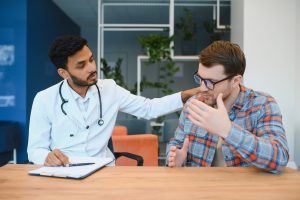
After a long pause, he admitted that he had been taking Percocet since a spinal surgery that had taken place years prior. The prescription was no longer active, but his dependence on the medication persisted. He had tried to quit, but had failed. As our conversation progressed, he cautiously added: “You are the only person I have told.”
The weight of those words was not lost on me. I knew what it meant to hold a secret so tightly that it threatened to hollow you out. For me, coming out as gay was an act of trust that I had doled out carefully — first to friends, then to mentors, always bracing for the possibility that my faith in them might be misplaced. Yet, I also knew the profound relief that follows when vulnerability is met with understanding. In medicine, trust is built in small, deliberate actions. It is in the way we ask questions, the way we respond to difficult truths, and the way we show patients that their honesty will not be received with judgment but with care.
Building a connection with Salman did not cure his addiction, but it allowed him to share his burden and take the first step toward recovery. His trust in me also enabled us to place a referral for specialists who could begin to manage his care.
That moment in the clinic underscores a broader truth: as the landscape of health care continues to evolve, so too does the nature of medical professionalism. Today, the practice of medicine extends beyond technical expertise or a hierarchical doctor-patient relationship; instead, it thrives on honesty, patient-centered care, and collaboration.
For many patients I have met as a medical student, health care is not simply about receiving treatment; it is also about feeling heard, respected, and understood. This shift is especially vital in communities where cultural differences shape health beliefs and generational divides influence faith in providers. I strive to be a physician who embodies this vision of professionalism — one who builds trust through humility, listening, and respect. By combining empathy with expertise, I hope to provide care that honors both the vulnerabilities and values of those I serve.
Adil Hassan is a pseudonym used at the request of the author. The author is a third-year medical student.
Bridging Generations in Medicine: Trust and Professionalism in a Rural Town
As the highway lights faded behind me and the stars emerged over the open country, I drove west toward Mineral Wells, Texas, for my Family Medicine rotation. Coming from the bustling suburbs of Dallas, I had never lived in a small town, let alone cared for patients in one. I expected to gain clinical knowledge, but what I hadn’t anticipated was how deeply the experience would shape my understanding of trust and professionalism in medicine.
In a town where everyone knew each other, the traditional boundaries between physician and patient blurred. My first lesson in trust came when I realized that my patients weren’t just patients. They were my neighbors, the people I saw at the grocery store, the barista who made my morning coffee, and the family that invited me to dinner. Unlike in Dallas, where patients could easily switch doctors, here, continuity of care was a necessity, not a choice. This reality carried weight: every interaction, whether in the clinic or outside of it, contributed to the trust patients placed in their physicians.
One evening, after finishing clinic, I stepped outside my condo and met a couple living next door. When they learned I was the “student-doctor,” they eagerly shared their health concerns. I reminded them I was still in training, but they nodded as if my white coat alone gave me authority. Caught between my duty to educate and my responsibility to acknowledge my limitations, I carefully framed my responses, emphasizing that they should follow up with my attending physician. It was in that moment I realized professionalism wasn’t just about medical expertise, it was about transparency, humility, and knowing when to defer to others.

Another pivotal moment came when an elderly rancher walked into the clinic, complaining of worsening back pain. His symptoms – persistent pain radiating to his abdomen, unintended weight loss – raised red flags. A workup revealed an abdominal aortic aneurysm, a life-threatening condition requiring immediate vascular intervention. In Dallas, an urgent surgical referral would have been routine. But here, the nearest specialist was over fifty miles away. The patient hesitated. Who would care for his cattle if he went to the specialist? Would insurance cover an out-of-town visit? My preceptor spent extra time explaining the risks, balancing medical urgency with the patient’s practical concerns. It was a masterclass in patient-centered care: one that required not just clinical knowledge but also trust-building through communication, empathy, and shared decision-making.
Throughout my rotation, I saw how generational perspectives shaped the practice of medicine. My preceptor, a seasoned rural physician, navigated these challenges with skill, but he also acknowledged how professionalism in medicine was evolving. For older generations, professionalism often meant unquestioned authority. Physicians gave orders, and patients followed them. But today, trust is built differently. It requires collaboration, transparency, and acknowledging the limitations of our own knowledge. I saw this shift firsthand when a young mother hesitated to vaccinate her child due to misinformation she found online. Rather than dismiss her concerns, my preceptor engaged her in a dialogue, acknowledging her fears while providing evidence-based guidance. This wasn’t just a conversation about vaccines, it was about restoring trust in medicine itself.
During my final weekend in Mineral Wells, I attended the town’s holiday celebration, recognizing many familiar faces. The sense of belonging I felt wasn’t just a reflection of my time there, it was a testament to the trust we had built. I learned that professionalism isn’t a rigid set of rules. It’s a dynamic, evolving concept shaped by relationships, values, and the needs of the communities we serve. In a small town, a physician is more than a provider. They are a trusted leader, a guide, and, at times, a friend.
As I continue my medical training, I carry these lessons with me. Trust is not granted by a white coat; it is earned through authenticity, ethical decision-making, and a willingness to listen. In an era where generational shifts and societal changes challenge traditional notions of professionalism, I’ve come to see that the heart of medicine remains the same: a commitment to our patients, our colleagues, and the communities we serve.
Benjamin “Benji” Popokh is a fourth-year medical student at the University of Texas Southwestern Medical Center in Dallas, TX. He is applying to residency in Family Medicine, with a focus on rural primary care and obstetrics. Outside of health care, Benji is passionate about long-distance running, reading, writing, and playing guitar.
The Clay Heart
In a hospital where codes echoed louder than lullabies and healing came measured in milligrams, there was a boy who carried magic in his hands.
Eight years old, small for his age, a quiet hurricane with wide brown eyes and wrists wrapped in tape. He knew every nurse’s name and every beep’s rhythm. Illness had settled into his life like a long-term guest, but he rarely let it steal the joy from his playroom kingdom.
I met him during my rounds as a volunteer. His sister was there too. Healthy, lively, and loud in the way only siblings of the unwell know how to be, trying to fill the silences illness creates. He was the one I watched, however. Focused, gentle, and meticulous with his clay, like he was modeling something more meaningful than people realized.
One afternoon, as I handed him a fresh ball of green clay, he looked up and whispered, “I’m making something for Dr. R.”
Dr. R. The young physician with kind eyes and sneakers instead of clogs, who traded formality for ease, who listened instead of lectured, who made medicine feel less formulaic and more like a conversation. The one who didn’t speak to kids like they were glass.
The boy’s hands moved with care, sculpting not just a figure, but a thank-you.
“She’s fixing me soon,” he added, as if this was just another thing to look forward to, like recess. “So I wanna give her something in case I forget.”
I didn’t know then that surgery was scheduled for the next morning. I didn’t know that his gift wasn’t just a craft. It was his way of holding onto something familiar, in case things felt different after surgery.
The hospital’s pace leaves little room for sentiment. A passing nurse glanced at the clay figure and offered a quick, “That’s nice, sweetie,” before rushing off. He didn’t need applause, just someone to care that it was finished.
And I did.
So when he handed me the clay heart – small, uneven, and green – I understood what he was giving me.
Green. The color of growing things. Of hope. Of something lasting beyond the cold white walls that tried to shrink his world.
“Can you give it to her?” He asked, his voice barely louder than the IV drip beside him. “In case I forget after surgery.”
I found Dr. R between cases. She paused as I offered her the gift, still soft around the edges, literally and emotionally. For a moment, she said nothing. Then she nodded, closed her hand around it, and whispered, “I’ll keep it safe.”
The playroom was quiet the following day.
No laughter. No sister. No clay under fingernails. Just silence, and the heaviness that follows when hope leaves too quickly.
The surgery, I later learned, had complications. Not fatal but frightening. Enough to shake a team that had grown used to pediatric resilience. Enough to make Dr. R keep the clay heart in her coat pocket every day that week.
He returned days later, slower, thinner, his chest sewn up and his eyes tired. When he saw me, his smile bloomed like spring after a harsh winter.
“Did she like it?” he asked.
I told him the truth: “She kept it.”
And I didn’t say the rest. That sometimes the smallest gifts are the ones that root themselves in people.
Trust is often discussed in medicine as something earned through skill, degrees, and exactness. Yet in that room, in that moment, it was built through something softer: presence. Honor. Listening when a child says, “This matters.”
It also made me reflect on how professionalism is evolving from rigid formality to presence, empathy, and emotional fluency.
Medicine once demanded distance, reserve, polished shoes, and practiced hands. But the children I met did not care how many white coats you owned. They cared if you remembered their favorite color. If you sat cross-legged on a tile floor to help shape a piece of their heart.
That moment reshaped how I define showing up in health care, not just physically, but emotionally, fully, and without ego.
That day, I learned that healing does not always come in cures. Sometimes, it’s the recognition that even in a sterile room of rules and protocols, a child can offer a gift not just of clay but of trust. I will carry that lesson with me.
And sometimes, the most professional thing you can do is kneel down, take it, and never let it go.
Brittany Ezenwa is an incoming medical student at the University of Texas Medical Branch John Sealy School of Medicine who is committed to uplifting underserved communities by promoting health literacy, fostering mentorship, and advocating for equitable access to care. She enjoys mentoring aspiring premed students, volunteering locally, and using social media to make the path to medicine more accessible. Outside of medicine, Brittany finds joy in cooking, fitness, photography, and exploring different cultures.
The Weight of Words
Some words are heavier than others.
Words like ‘cancer,’ ‘surgery,’ or ‘coma.’ They are the words that make everything else blur into a haze. On my internal medicine rotation, one particular word shattered and shaped the rest of someone’s life.
Hospice.
It was just seven letters typed into a chart, but for her husband, it wasn’t just a word. It was a verdict. A death sentence. A thief who snatched away any remaining hope without his permission. His voice erupted down the hospital hallway as we made our way through rounds. His grief was so raw and his anger so fierce that the walls seemed to shake.
His wife was only 53, locked in a losing battle with metastatic pancreatic cancer. After four weeks of procedures, we were running out of options. The interventional radiology team had placed several internal-external biliary drains, our last effort to control the cancer. Days later, she went into septic shock. With her oncologist on board, the team recommended hospice.
“How dare you give up on her? How dare you write that in her note? Now no one else will try,” he shouted. The air thickened.
“When did medicine start abandoning people when things get hard?” For some, especially those who grew up believing medicine must always fight, the idea of comfort care feels synonymous with surrender. This perspective isn’t uncommon. For decades, the medical profession’s focus has been on prolonging life at all costs. However, conversations about end-of-life care have shifted. Prioritization of dignity and comfort over futile intervention has become increasingly seen as a form of compassionate, patient-centered care.
“We will come by shortly and talk in private,” the physician said calmly. But the husband wasn’t ready. He stormed away, consumed by anguish.
Later that day, I found him sitting by her as she slept, peeling the skin off his knuckles. I pulled up a seat next to him.
“Can you tell me about her?” I asked.
He sighed, his face softening. “She’s my best friend. We met in college, and I knew right away I never wanted to let her go. She’s hilarious, and she makes this cute squeaky sound at the end of her laugh. She’s ridiculously smart and so curious about the world. She loves photography, especially of plants.” His voice broke.

“I don’t know who I am without her,” he said tearfully. “She’s my best friend.”
I nodded. “She sounds wonderful. I can’t begin to imagine how you’re feeling.”
I visited him daily. Once after morning rounds, and again in the afternoon. Some days he wanted to ask exactly what a ‘bilirubin’ was, others were him showing me photos to relive a memory. I listened without steering the conversations. Slowly, he began asking more about hospice, though he’d always add, “I’m just asking. That’s all.”
When the palliative care team arrived, they took the time to meet him and explain their role. They spoke about comfort, about dignity, about how hospice didn’t mean giving up, but choosing how she would spend her remaining time. They answered his questions and addressed his fears. Some days he stormed out, others he lingered a little longer to hear them. Their patience reminded me that professionalism doesn’t demand immediate agreement but allows space for uncertainty. Over time, his uncertainty stopped consuming him.
When he began to listen instead of walking away, I felt his grief change from anger, to fear, to something that resembled trust and acceptance. It was no longer the team versus him. He saw that we were on the same side.
I will never forget the anger in his voice that morning. In that moment, the mechanisms of disease and memorizing treatment protocols no longer mattered. I used to think professionalism was about knowing the answers. But I now understand it’s just as much about standing with patients and their loved ones in their darkest moments. It is about being steady in the storm of others’ pain. It is about having the courage to hold someone’s suffering alongside them.
Some things, as doctors, we cannot fix. But trust is an exception. It is earned by remaining present, even when the bridge gets shaky. As a student, I didn’t need to make any grand gestures. I simply needed to stay.
We can ask, “Can you tell me about her?” And then, we can listen. Because while some words are heavier than others, trust has a weight of its own that can be powerful enough to help carry people through.
Rana Barghout is a third-year medical student at Weill Cornell Medicine. She earned her bachelor’s degree in neuroscience from Amherst College. She is passionate about improving care for vulnerable populations and advancing health equity. In her free time, she enjoys stand-up comedy shows, escape rooms, and exploring New York City.
Peeking Behind the Curtain
“They’re anti-vaxxers – they won’t listen.” My resident whispered to me as we finally walked away from Johnny, the 6-month-old baby boy in Room 9, one hour and some odd minutes later.1,2 His tone is heavy, laden with implicit meaning. The pediatric hallway mural flashes by as we walk, a jewel-toned jungle depicting grinning monkeys gamboling amidst a wash of bright emerald-green leaves.
After several formative interactions with the family, a palpable sense of dread began to accompany our daily prerounds. My resident and I struggled daily to convince them to allow basic blood draws; we failed utterly on the topic of flu shots.
My resident, usually composed, started displaying a series of nervous tics, from pausing outside the door to breathing deeply just before knocking. Eventually, we resort to maintaining an exit pathway to the door, as if to subconsciously escape the daily question bombardment on our clinical judgment and the veracity of scientific rationale, all delivered in an aggressive tone by the parents and fueled by anti-science skepticism. By the third morning, I found myself too exhaling in relief by the time we exited Room 9.
The fourth morning, an attending who favored bedside rounds joined our team. Huddled en masse outside Johnny’s room, I was stunned to see how calmly and patiently my attending fielded the family’s questions, modeling compassionate patient-centered care for the entire team and serving as an important reminder to us all.
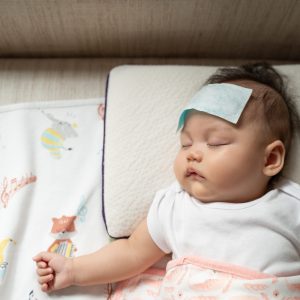
Like Dr. Paul Kalanithi once wrote in his gripping memoir When Breath Becomes Air, “The easy human connections he formed, the trust he instilled in his patients, were an inspiration to me.”3 I felt ashamed, realizing I had allowed anxiety to cloud my normal interactions. Antivaxxers or not, the family in Room 9 deserved care to the best of my ability. I returned to Johnny’s room that same day, resolved on immediately changing my attitude.
When Johnny’s family initially responded to my discourse invitation with closed-body language, I was frank yet sincere, “I want you to know I am here to listen with an open mind. I would deeply appreciate the chance to hear your feelings.”
As if suddenly unfettered, they spilled their fears out to me. I left the room hours later, humbled with my heart in my mouth. I realized what we had formerly written off as an aggressive tone was a tone of utter terror; the anti-science skepticism in Room 9 was actually a first-time mother and father’s panic over their acutely sick child and an understandable distrust of a confusing medical system.
In his Harvard Business Review article on eroding trust in U.S. health care, Dr. Richard S. Isaacs aptly notes, “Every [patient] encounter… is an opportunity to build trust,” a countermove to the deepening credibility crisis in the medical system, especially prevalent in conservative spaces.4-6 Our initial mistake was attempting to convince Johnny’s parents about scientific evidence, thus creating a patient-provider impasse, rather than first empathizing with their concerns.
The day Johnny took a turn for the worse, my team advised urgent placement of a central venous catheter under anesthesia during attending rounds. Johnny’s parents balked, immediately wary of the potential harms of unknown chemicals and an invasive procedure on their precious baby.
Afterwards, I stopped by to check in gently. “What are your concerns?” I remember asking them as I stroked Johnny’s hair soothingly. As Dr. Kalanithi aptly described, those moments in Room 9 became “an opportunity to forge a covenant with a suffering compatriot: here we are together, and here are the ways through – I promised to guide you, as best as I can, to the other side.”3
By the time evening rolled around, I emerged from Room 9, hopeful.
The next morning, Johnny’s parents consented to the central venous catheter placement, provided I accompanied their baby boy every step of the way. I promised to stay with him, asked permission from my chief, donned an OR bonnet for the first time in my life, and wheeled Johnny out from Room 9. Later, in the same bonnet, I brought Johnny back to his tearful parents.
In the operating room, the blue curtain behind which anesthesia often sits is a common sight. But in the world of patient care, that curtain can exist unseen. It is essential to remember to peek behind that curtain in each of our Room 9s, see our patients behind a stereotype or impression, and take the time to listen rather than explain. It is our role as providers to make every single one of our patients feel heard.
Melodyanne Cheng, MS, is a fourth-year MD/MBA candidate at UCLA David Geffen School of Medicine. Originally from San Diego, CA, they are focused on improving surgical health disparities, redesigning more equitable health care delivery systems, and impacting patient care from bench to bedside.
Notes and References
- Johnny is a fictional pseudonym to maintain patient privacy.
- The room number and Johnny’s exact age are both modified/fictional to maintain patient privacy.
- Kalanithi, Paul. When Breath Becomes Air. Random House, 2016.
- Isaacs, Richard S. “5 Steps to Restore Trust in U.S. Health Care.” Harvard Business Review, 8 Sep. 2022, https://hbr.org/2022/09/5-steps-to-restore-trust-in-u-s-health-care.
- Boyle, Patrick. “Why Do People Believe Medical Misinformation?” AAMC, 3 Nov. 2022, www.aamc.org/news/why-do-people-believe-medical-misinformation.
- Boyle, Patrick. “Why do so many Americans distrust science?” AAMC, 4 May 2022, https://www.aamc.org/news/why-do-so-many-americans-distrust-science.
Making Sense of the Unfamiliar
My dad turns off the Wi-Fi at 10:30 every night. He bought an automatic timer last month so he can’t forget. He wants to minimize the amount of time our bodies are exposed to the electromagnetic fields generated by Wi-Fi signals. I’m ready to tell him it’s ridiculous, but I know that won’t change his mind. After all, it has nothing to do with education (he has a graduate degree) or irrational thought (studies have looked at the effect of phones on sperm count). It’s just how he copes with something unfamiliar.
During the past few years, more and more health conspiracies and conspiracy-like ideas have found their way into the spotlight. COVID-19 generated a new thread of conspiracies, partly in response to mRNA technology.1 There were theories about vaccines injecting 5G microchips that Big Tech and Big Brother were using for surveillance. There was Donald Trump suggesting we inject bleach to kill the virus. There were people declaring that COVID-19 wasn’t real and neither were the death rates. There were the usual conspiracies igniting anti-vaxx and anti-pharma and anti-establishment furor. Studies found that increased exposure to conspiracy theories led to increased reluctance to engage in COVID-19 prevention measures, such as social distancing and vaccination, along with increased willingness to engage in alternative treatments, such as chloroquine and garlic.2 Such phenomena are not specific to COVID-19 either.3
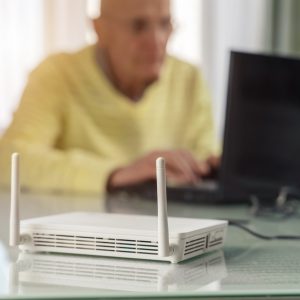
Health conspiracies often sound similar to the messaging associated with alternative health movements and wellness culture, terms that broadly encompass everything from yoga to acupuncture to reiki. Wellness culture arose from 1960s counterculture that sought to experiment with holistic practices and increase access to healthcare.4 But today, wellness culture is primarily dominated by chatty influencers promoting trends on unregulated platforms, at times creating fodder for conspiracy theories that can align with far-right political agendas.4 Not only does this debase alternative medicine practices that can actually help people,5 but this also creates demand for people who consistently make unsubstantiated and misleading claims.6
But it’s not helpful to deride conspiracy believers as outright delusional. That’s not entirely fair. Conspiracy theories have a long history rooted in distrust of political elites and central authority. They are attempts to understand sociopolitical events, especially during times of upheaval, by claiming that people in power are colluding for malevolent purposes.7 They share four principles: they are universal in that they are not specific to a group of people or to a period of time but rather part of basic human survival mechanisms; they are emotional in that they are a product of emotion-driven sense-making processes that often draw upon automatic cognitive systems; they are social in that they seek to uphold collective identity and protect the ingroup from the outgroup; and they are consequential in that they influence the way individuals and groups decide to act.8 Many false beliefs, even those that do not qualify as conspiracy theories and especially those that hold the vaguest hint of plausibility, share similar principles and similar consequences. But no matter where they lie on a spectrum of truth, they all stem from the same sentiment: fear of the unfamiliar. They are all driven by epistemic crises and existential threats—things we all experience.7
Preserving truth and building trust is not just about censuring all falsehoods and all believers. Whether it’s in medicine, politics, or daily life, it’s foremost about understanding why someone chooses to think the way they do. Most of us don’t respond to scientific literature or hard evidence. We respond to our own versions of truth, versions based on our individual lived experience and on our shared struggle to be human.
Fifty years from now, I wonder how I’ll cope with a technologically unfamiliar world. When AI has found a grip on many parts of our lives, I can imagine myself being distrustful of most information—I’m already wondering if the Reddit video of a Russian man brushing a bear’s teeth is just a figment of the AI imagination. When that happens, I might also find myself turning off the Wi-Fi at 10:30 every night, in part to get off the grid, maybe also in part to avoid unnecessary electromagnetic radiation. Deep down, we all have a voice like this, a voice that is anxious about the unfamiliar and perhaps unsure of the science. And that’s okay. We should talk about it with each other because we’re all just trying to make sense of the same things.
Meilynn Shi is a medical student at Northwestern University, pursuing a path in academic cardiac surgery. She received her bachelor’s in American Studies and Political Science at Northwestern University. She likes running, cooking, reading, and writing.
References
- Dolgin E. The tangled history of mRNA vaccines. Nature. Sep 2021;597(7876):318-324. doi:10.1038/d41586-021-02483-w
- Bierwiaczonek K, Gundersen AB, Kunst JR. The role of conspiracy beliefs for COVID-19 health responses: A meta-analysis. Current Opinion in Psychology. 2022/08/01/ 2022;46:101346. doi:https://doi.org/10.1016/j.copsyc.2022.101346
- Oliver JE, Wood T. Medical Conspiracy Theories and Health Behaviors in the United States. JAMA Internal Medicine. 2014;174(5):817-818. doi:10.1001/jamainternmed.2014.190
- Baker SA. Alt. Health Influencers: how wellness culture and web culture have been weaponised to promote conspiracy theories and far-right extremism during the COVID-19 pandemic. European Journal of Cultural Studies. 2022;25(1):3-24. doi:10.1177/13675494211062623
- Yang Y, Li X, Chen G, et al. Traditional Chinese Medicine Compound (Tongxinluo) and Clinical Outcomes of Patients With Acute Myocardial Infarction: The CTS-AMI Randomized Clinical Trial. JAMA. 2023;330(16):1534-1545. doi:10.1001/jama.2023.19524
- Korownyk C, Kolber MR, McCormack J, et al. Televised medical talk shows—what they recommend and the evidence to support their recommendations: a prospective observational study. BMJ : British Medical Journal. 2014;349:g7346. doi:10.1136/bmj.g7346
- Douglas KM, Uscinski JE, Sutton RM, et al. Understanding Conspiracy Theories. Polit Psychol. 2019;40(S1):3-35. doi:https://doi.org/10.1111/pops.12568
- van Prooijen J-W, Douglas KM. Belief in conspiracy theories: Basic principles of an emerging research domain. European Journal of Social Psychology. 2018;48(7):897-908. doi:https://doi.org/10.1002/ejsp.2530
Breaking Silence
“For the most part, our patients are wonderful individuals but…,” our Psychiatry clerkship director paused to start passing out personal safety alarms, “you should always have your device nearby while on the unit.”
Her instructions seemed a bit dramatic for my rotation, which was set to take place on the
Child and Adolescent (CAP) unit. When we submitted our site preferences, I envisioned bleached white walls and squashy couches where I would learn how to best support young minds during that tricky transition from adolescence to adulthood.
“Raymond” was the first patient I admitted from the Emergency Department. His parents brought him in after he barricaded himself in the bathroom and texted the family group chat that he was going swallow 10 bottles of Tylenol pills. I asked Raymond if he had any details that he wanted to add from his parent’s account, but he wasn’t interested in answering my questions—or talking to me —in any capacity.
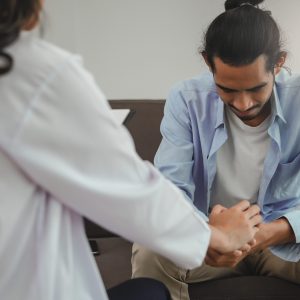
Once he arrived on the unit, Raymond mostly kept to himself. He was highly intelligent but socially isolated. He spent time outside of mandatory group therapy sessions working on puzzles or sometimes, staring out the window overlooking the main boulevard in front of the hospital. I wondered what kind of life existed for him in the outside world, but he refused to engage in any meaningful conversation about his thought process.
Our CAP fellow was not surprised by this behavior. He, like Raymond, was raised by Chinese immigrants and initially decided to pursue Child and Adolescent Psychiatry because he saw the need for more culturally sensitive providers to destigmatize mental health for Asian Americans.
“You have to understand, this is a sixteen-year-old kid who maybe never learned how to have an open conversation about his feelings because some of those words don’t even exist in Mandarin. Give him time.”
In Child and Adolescent Psychiatry, we were instructed to think of our patient’s presenting problem in the context of their environment. Scribbled on the workroom whiteboard were a series of concentric circles labeled “Patient,” “Family,” “School/Peers,” and “Community.” Each circle played a role in their disease pathology and as providers we needed to think about treatment options that offered the most over-lap between all the circles.
Eventually we untangled a complicated dynamic of intense feelings of sadness and loneliness that started when Raymond was in middle school. He knew that his parents loved him but didn’t know how to describe why he felt so alone, especially after knowing how much his parents sacrificed to raise him in America.
Raymond’s experience reflects current demographic data that shows Asian Americans are less likely to receive mental health treatment compared to other racial and ethnic groups. A study from Health Affairs found that 58 percent of Asian Americans reported worsening mental health after the COVID-19 pandemic and accompanying wave of racially motivated hate crimes, exacerbating an already profound need for culturally and linguistically sensitive mental health providers.1 There is no panacea for eliminating health disparities. Some professionals call for greater education about the science behind pharmacologic agents such as SSRIs to dispel thinking that mental health conditions are a result of personal failure. Others emphasize greater acceptance of traditional healing methods through integrative medicine. However, the literature consistently shows the importance of acknowledging cultural background in establishing patient-provider trust and building a strong therapeutic alliance.
One morning during rounds our attending asked Raymond to consider family therapy as a communication tool with his parents so they could learn from each other how to best support Raymond. This would be a change in their family dynamic, but something his parents were open to when the treatment team privately explained to the importance of speaking frankly about his mental health.
At first, Raymond didn’t respond. Just as the silence was becoming awkward, our fellow asked Raymond a question.
“Raymond, are you scared?”
He sunk his teeth into his bottom lip before nodding in agreement.
“I’ve been speaking with them every day and they’re not mad at you. They love you and really want to help you get better. Even if it means trying something new.” Challenging centuries old behavior and creating space for emotional vulnerability is scary. But when there is mutual respect and understanding of someone’s background, physicians can empower patients to build the confidence necessary to take the first step in the right direction.
Kaveri Curlin is a third year PRIME LEAD-ABC medical student at University of California, Irvine School of Medicine. She attended Yale University for her undergraduate studies, and she is interested in using story telling as a form of patient advocacy.
References
- “Addressing The Mental Health Needs Of The AAPI Community,” Health Affairs Blog, September 1, 2021. DOI: 10.1377/hblog20210827.800655
From Resilience to Relief
Max stumbles into the kitchen, sees me sipping my coffee, and hugs my neck – he’s got a fever. “Hi, Aunt Meg,” he mumbles, his sweet 5-year-old voice slightly muffled. I ask my sister when my nephew was last on antibiotics – two weeks prior.
“I think he might have strep again…” My current status as a medical student, coupled with the knowledge that Max had been treated for recurrent streptococcal pharyngitis gave me the confidence to make this statement. “Dios mio,” my brother-in-law mutters under his breath. “Are you sure?” I tell him that I am not, but I recommend a trip to the pediatrician.
A couple of hours later, the diagnosis is confirmed. It is Max’s sixth time to have strep throat in as many months, and he has been prescribed yet another round of amoxicillin. His pediatrician has made a referral to an ear, nose, and throat (ENT) specialist to discuss a possible tonsillectomy.
“Absolutely not. They are not cutting into my son!” my brother-in-law declares, making his position clear. A college professor with a PhD in physical chemistry, W is one of the most intelligent people I know. He is thoughtful, analytical, and rational. He also has a deep distrust of the medical system.
W was born and raised in the Dominican Republic. His earliest memories of the medical system are entangled with the death of his father; later health care memories are tied to the death of his older brother. While in Puerto Rico for his doctoral studies, he said his final goodbyes to a close friend who died due to complications from an elective heart procedure. W’s distrust of the medical system is not without good reason, and he is understandably hesitant about the possibility of his young son undergoing surgery.
“Can you talk some sense into him?!” my sister huffs as she moves to put the pink liquid medicine into the refrigerator. I look from her to him to Max, who, feeling miserable, has curled himself up on the couch.
My gut reaction is to play the role of the concerned aunt – appeal to my brother-in-law’s emotional side and talk about how much better his son will feel once his infection-prone tonsils have been removed. But then I consider how deeply W loves Max. His resistance to surgery does not come from a disregard of his son’s comfort, rather, I can see on his face that he is terrified about what outcomes may arise from a tonsillectomy.
“What concerns do you have?” I ask, reminding him that, as a student, I likely will not be able to address them all. “That doctor talked too fast. It was like she didn’t want me to know what was going on, and she just wants to operate!”
We talk. He wants to know why a tonsillectomy is favorable to repeated courses of antibiotics. I speak about antibiotic resistance and alteration of gut microbiome. He asks about the risks associated with tonsillectomy. I tell him about the recovery period, pain control, and the risk of bleeding. He wonders why they took so long to suggest surgery if this is the best option. I review with him the American Academy of Pediatrics recommendation for recurrent strep throat and criteria for tonsillectomy. He asks if I think having Max’s tonsils out is a good idea. I tell him I do. He asks if I think Max will be safe. I tell him I do. I help him develop a list of questions to discuss with the ENT, and I tell him his concerns are valid. Then I take off my medical student hat, return my aunt hat to its rightful place, and I watch cartoons with my nephew.
Trust is integral to successful medicine, and as a student, my responsibility to build trust does not end when I leave the hospital. One’s lived experiences often take precedence over rationality and knowledge when trust is at stake – even though my brother-in-law is a highly educated, logical individual, he does not automatically trust the recommendations of a physician simply because they are rooted in science. As health care professionals we must listen and strive to understand in order to build communication that facilitates trust.
W was able to discuss his concerns over Max’s surgery with the ENT. The physician sat down, took her time, and addressed his questions thoroughly. Though still nervous, W agreed to proceed with the surgery, and Max is now successfully tonsil – and strep – free.
Meg Sorg will be starting her second year of medical school at the University of Kentucky College of Medicine this August. She is a nontraditional student with a background in pediatric nursing, and she loves spending time with her husband and four young children.
Whispers of Solace: My Journey as an Abortion Doula
I rearranged the consult documents on my desk for the hundredth time as I waited for a call from an unknown number. When it rang, I took a deep breath and answered, greeting my first consult as an abortion doula. We were both nervous to be speaking to one another, yet in our vulnerability we found solace. I was a 21-year-old medical student, and she was a 40-year-old single mother of two facing an impossible decision.
I could sense her fear from the very beginning. Her current pregnancy was unplanned, and although unexpected, she decided to carry it to term because she couldn’t bear the idea of a termination. Yet, on her fourth prenatal visit she was informed of a genetic defect that would result in the demise of her fetus. After countless doctor visits in search of a second opinion and enduring isolating sly remarks of some family members, she reached out to our team of doulas.
At its core, the role of an abortion doula is to offer support in a way that honors a patient’s experience and preserves their dignity. I have had the privilege of working in the field of reproductive health, which has allowed me to understand what an abortion implies. Nevertheless, I know that is not the experience for most Puerto Rican women. Therefore, ensuring a safe space for her to entrust in me what is surely one of her most difficult life experiences demanded insurmountable sensitivity, patience, and comprehension.

Establishing a rapport with patients is difficult, and having to do this over the phone during a pandemic made it even harder. To me, an abortion offers security, control, and freedom but to her the concept of abortion was riddled with shame and fear. Most of these negative emotions stem from the secrecy that surrounds reproductive health and the lack of agency she has had over her own body throughout her life.
So, as a means of preserving her autonomy during our conversation I adopted the language she used to describe her situation. Throughout our calls we spoke about the “baby” instead of a “fetus” and a “procedure” or “God’s will” instead of an “abortion” or “termination.” This simple adjustment to my selection of words created a space for her to share her experience without tainting it with my personal beliefs.
Forty-five minutes into the phone call I knew we had transcended past the trepidation of our initial greeting when she asked if she could read me a poem she wrote after her last doctor’s appointment. What followed was proof of the power of thoughtful listening. After her reading I confessed that I also write poetry and so we spent the last fifteen minutes of our call sharing our poems with one another. It is not often that we get to witness the sheer vulnerability of another human being, yet if we are willing to learn and be receptive to the experiences of others, we find ourselves able to achieve extraordinary connections.
It is difficult to overcome the stigmatization and misinformation that holds reproductive and sexual health care hostage. For this reason, cultivating a multifaceted approach that is founded on a genuine selfless interest for our patient’s wellbeing can make a difference in every interaction. I’m grateful for the opportunity of being a doula, as it has given me the chance to deconstruct the barriers people face when seeking such health care services and improving the ways in which I can connect with others to provide excellent care to those that need it most.
Claudia Sofía Rivera Barbeito is a third-year medical student at the University of Puerto Rico School of Medicine. Her interests include reproductive justice, maternal fetal medicine, and health care policy. In her free time, she enjoys hiking, painting, taking photographs, and playing tennis.
Reading Between the Lines: Unveiling Cultural Understanding to Build Trust in Patient Care
Last year, my mom was diagnosed with Stage 4 ameloblastic carcinoma, an exceedingly rare form of cancer. This diagnosis instilled profound fear in my immigrant parents, who harbored a deep-seated distrust of medical institutions due to their past experiences with inadequate health care in their home country.
In their eyes, a medical diagnosis as intimidating as “cancer” meant: “death.” Witnessing my mom’s apprehension during countless doctor visits and engaging in meaningful dialogues with her emphasized the paramount importance of fostering genuine human connections between health care providers and patients. This experience provided me with invaluable insights into effective methods of building trust, prompting me to reflect on my own interactions with patients. I aspire to share and expand upon these lessons throughout my career as a physician.
My mom’s diagnostic odyssey was characterized by many misdiagnoses, with doctors attributing her symptoms to the stresses of a working mother. Eventually, her worsening symptoms prompted them to label her condition as periodontal disease, despite her gums being perfectly healthy. Through our conversations, I observed the impact of cultural nuances on patient care, as my mom, feeling dismissed by doctors she once trusted, internalized her pain, and suffered in silence as women typically do in South Asian culture.

While she was eventually diagnosed with ameloblastic carcinoma, she explained that her lack of faith and cultural biases had influenced her conservative decision for only the surgical removal of cancer, denying other treatments. Witnessing the harmful manifestations in my mom’s physical and psychological health, I encouraged her to seek doctors that prioritize active listening and cultural competency.
Rather than leading patients astray with false assurances and misinformation that can be compounded by past traumas and unreliable sources online, I explained the value of physicians acknowledging the limits of medical information. My contrasting suggestion was to accept the radiation and reconstruction treatments. This dialogue with my mother, who was battling uncertainty as a rare condition patient, not only fostered trust but also empowered her to actively participate in her own care, following through with the appropriate treatments from doctors who could understand her story.
From this experience, I learned that nurturing patients’ trust requires viewing them as individuals with unique stories, fears, and aspirations, rather than as mere cases to be solved. Furthermore, the quality of patient-provider relationships relies on doctors’ promotion of cultural competence and health equity.1
I recall a particularly poignant, different encounter during my time as part of a medical team in Haiti. Amidst the backdrop of poverty and limited access to health care, I witnessed the profound impact of bonding with patients to provide comfort.
One instance stands out vividly. I encountered a patient named Marie, a middle-aged woman, who was seeking relief from chronic back pain. Her pain was not just physical but also emotional, stemming from years of laborious work carrying heavy baskets on her head for long distances, without access to proper medical care. As I examined her, I recognized the fear in her eyes, mirroring the same emotions I had seen in my own family during my mother’s illness. As she shared her daily struggles, I could sense her apprehension towards my broken Creole, which was similar to the interactions I witnessed with my parents.
However, I couldn’t help but empathize with her plight. Living and working alongside the community allowed me to experience their daily struggles firsthand. Having set up camp in an isolated mountain village, I pulled water from a well, slept on the floor in homes without electricity, and adapted to the local conditions. I understood the unspoken reality of how Marie’s cultural environment exacerbated her condition. These implicit experiences allowed me to ease Marie’s doubts about whether a foreigner could understand her pain.
As I continued my verbal and non-verbal engagement with Marie and her community, a sense of camaraderie began to form. Her shift in perspective regarding my cultural competence allowed me to no longer be an outsider but instead an ally working to address her health care needs. My conversations with Marie became more meaningful, considering not just her physical symptoms but also the underlying social determinants affecting her well-being.
By attentively acknowledging patients’ cultural environments through open conversations, physicians’ bonds with patients can flourish, transcending language and cultural barriers and uniting us in a shared commitment to patient well-being.2
I learned building trust with patients is not confined to the walls of a hospital or clinic. It is a universal language of compassion and empathy that transcends surface-level dialogues to a deeper understanding of our patients’ diverse backgrounds.
Nitya Devisetti is a medical student at Rutgers New Jersey Medical School (in the Combined BS/MD Program) in Newark, NJ. She is passionate about promoting accessible health care to underserved populations. Pursuing this passion, she has interned at the Penn Injury Science Center and Centers for Disease Control and Prevention (CDC) where she did research on the social determinants of health. Recently, Nitya won $20,000 in a business plan competition, detailing her business idea for affordable health care inspired by the current state of the health care system and recent Price Transparency Laws. In her free time, Nitya likes to experiment with nail art, cook plant-based meals, and exercise with her dog, Cookie.
References
- Saha S, Beach MC, Cooper LA. Patient Centeredness, Cultural Competence and Healthcare Quality. Journal of the National Medical Association. 2018;100(11):1275-1285. doi:https://doi.org/10.1016/s0027-9684(15)31505-4
- Stubbe DE. Practicing Cultural Competence and Cultural Humility in the Care of Diverse Patients. Focus. 2020;18(1):49-51. doi:https://doi.org/10.1176/appi.focus.20190041

